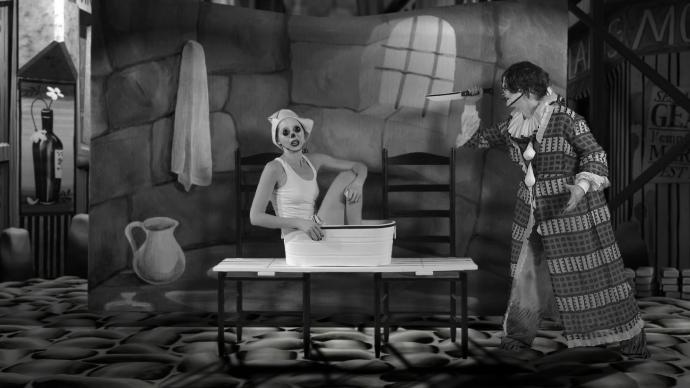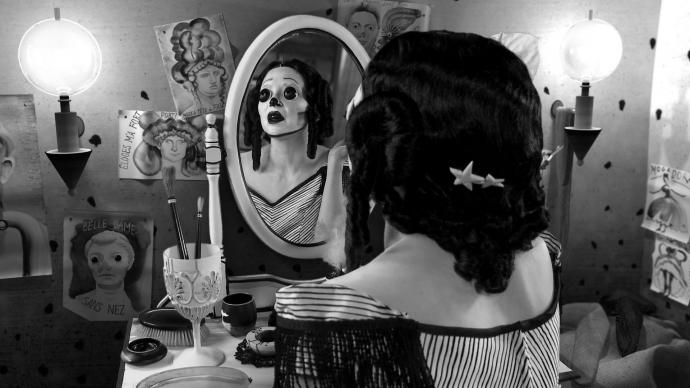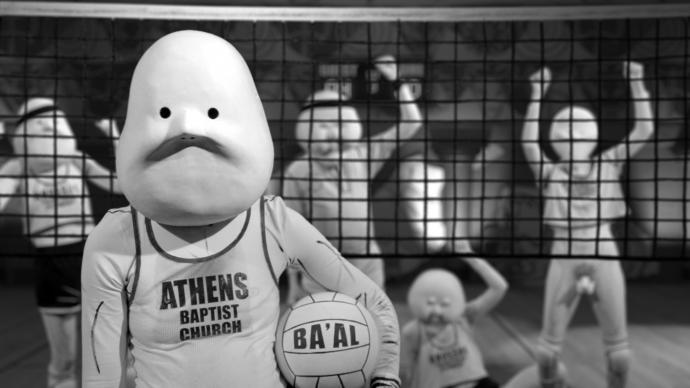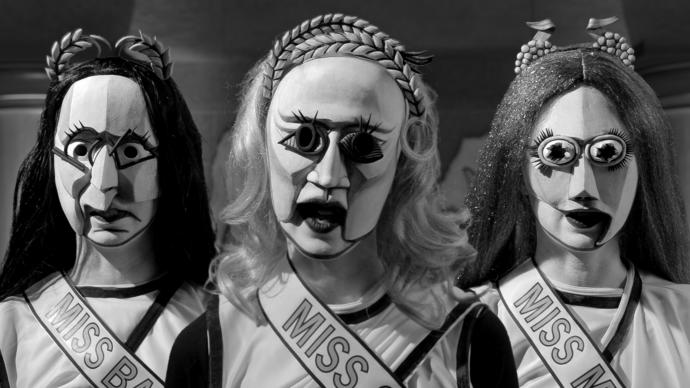from pastelegram.org, June 2011 – April 2014
Mary Reid Kelley: Priapus Agonistes
Mary Reid Kelley’s videos, which have garnered significant acclaim since the artist began showing widely about four years ago, are a nerds’ orgy. Their distinctive visual language—constructed black and white landscapes reminiscent of German Expressionist films, along with cartoonish period costumes and makeup—is immediately arresting, while their layered historical narratives and lyrical punning invite repeat viewings. Written in iambic pentameter and other ancient verse forms, Kelley’s stories are so steeped in various details of European history and culture that many viewers will miss at least half of the references; to even get the gist of Kelley’s messages requires a strong basic knowledge of topics covered in college history and literature courses.
The artist’s most recent solo exhibition in Los Angeles unveiled her newest video, Priapus Agonistes (2013), made in collaboration with husband Patrick Kelley, shown alongside an older video, The Syphilis of Sisyphus (2011) and a collection of works on paper inspired by images from the two videos.

Mary Reid Kelley with Patrick Kelley, still from The Syphilis of Sisyphus, 2011; single channel HD DVD with sound; 11 minutes 2 seconds; image courtesy of Susanne Vielmetter Los Angeles Projects.
The Syphilis of Sisyphus presents a tangled web of allusions conflating the artifice of feminine beauty, Baron Haussmann’s radical renovation of Paris, the march of Western progress and the ongoing struggle to keep provincial/natural ugliness at bay. “Make beauty boulder!” cries the video’s protagonist, a pregnant French grisette (a working-class woman who may also be a prostitute) named Sisyphus, as she rolls the proverbial boulder uphill. As Sisyphus exits her boudoir, her monologue expands into a playful look at French history that is acted out on the cobblestone streets of pre-Haussmann Paris with the help of a group of Pierrots (pantomime stock characters from European street theater). The contributions of Diderot, Marie Antoinette, Robespierre, Napoleon, Haussmann and others pass in short comic order, and the silliness climaxes when the former prostitutes of the newly gentrified city protest, “’Twas I who baguette you!” while striking one another with baguettes.
Sisyphus joins in the fray, throwing baguettes into the street, but is quickly arrested and sent to La Salpêtrière, a hospital and prison notorious for housing street prostitutes and the mentally ill. There, she is studied by the physicians even as she protests, “A pillar of culture like me can dispense / With these charlatan quacks, and their breeches of confidence!” in a seeming reference to the incarceration of artistic or creatively inclined women. She attempts to recruit her captors to “a cloister that’s moister, a womb of one’s own / My Sorbonne in the oven is nationally known.” The video ends with a resonant flourish when Sisyphus makes peace with her own excess and likens herself to the “polyamorous bride, who announced with a grin / After wedding the crowd: Goodbye, Nature, and Hi, Men.” The mock wedding that ends this video seems to compare progress and modernization with the violation of nature in general and women’s bodies in particular.

Mary Reid Kelley with Patrick Kelley, still from The Syphilis of Sisyphus, 2011; single channel HD DVD with sound; 11 minutes 2 seconds; image courtesy of Susanne Vielmetter Los Angeles Projects.
Kelley’s videos have grown steadily in sophistication and complexity. Her earliest works tended to favor a protracted single-shot focus on a lone protagonist, who dutifully recited the author’s compositions. Over the years, Kelley has incorporated lively stop-motion interludes, more characters, more elaborate sets and a greater variety of camera angles, creating a fuller visual experience. This is certainly the case with Priapus Agonistes, the first work that is co-credited to Kelley and her photographer husband. Combining references to classical Greek drama and mythology, competing strains of Christianity, American church volleyball tournaments, county fairs, and Borgesian allegory, Priapus Agonistes is Kelley’s most ambitious work to date, weaving together a diverse cast of characters and using a less didactic and more cinematic storytelling style.
The story pits the Athenian Baptists against the Presbyterians of Knossos in a church volleyball match, narrated by a Greek chorus of three women named Miss Barley, Miss Millet and Miss Spelt. Tournament losers must descend to the labyrinth below the church, where the resident Minotaur will devour them. When Athens senses it’s in trouble, the players bring out their MVP, an arrogant young man with a fish over one eye named Priapus. Priapus hoists the “Ba’al,” which comes back down to earth as “wrath” (presumably of God), striking down a deacon playing for the Presbyterians. We then visit with the Minotaur, who is, surprisingly, female. While roaming the labyrinth, she ruminates on her strange circumstances and longs for a redeemer. (This passage is heavily indebted to Jorge Luis Borges’ 1947 story “The House of Asterión,” in which Borges re-imagined the Minotaur as a reflective and tragic anti-hero.) In a flashback sequence, we see how Venus (ironically portrayed as a dog) resolved her bitchy power struggle with the beautiful Pasiphae by making her fall in love with the Cretan bull, which resulted in the birth of the Minotaur.

Mary Reid Kelley with Patrick Kelley, still from Priapus Agonistes, 2013; high definition video with sound; 15 minutes, 9 seconds; image courtesy of Susanne Vielmetter Los Angeles Projects.
Back in the church gymnasium, faced with a dwindling population of volleyball players, Priapus comes forth with a plan to kill the Minotaur with the help of Ariadne’s spindle. He brags about his qualifications for such a deed, listing his long résumé of wartime accomplishments and revealing himself as an all-purpose stand-in for both Theseus and Christ. When Pasiphae appears and sheds a tear, Priapus scolds her with “You feel your shame but do not cease to love it.” Pasiphae responds, “It’s not shame I feel, it’s little pricks / Of conscience.” Priapus’ last words, before descending ominously into the labyrinth with Ariadne’s spool unraveling behind him, are “O Queen I’m at your cervix. / I’m not the hand, nor yet the sword, / I’m just an organ of the Lord.”
As in The Syphilis of Sisyphus, Priapus Agonistes (which can be loosely translated as “Phallus Conflicted”) ends with an allusion to a wedding or copulation of sorts, which in turn stands in for larger ideas involving modernity, progress, and conquest. As the “organ” stands before the “cervix,” Priapus (the phallus) prepares to descend into labyrinthine depths (the vagina) to once again conquer nature (the feminine to his masculine) and restore the social order, even as Pasiphae feels “pricks” of conscience. The hybrid Greek temple/Christian church sits atop the menacing labyrinth much as conquering civilizations built their structures directly atop the ruins of the conquered, absorbing the older mythology into their own. Kelley’s narrative seems to point at the uneasy relationships and power dynamics that fuel what we believe to be the march of civilization or even Manifest Destiny.

Mary Reid Kelley with Patrick Kelley, still from Priapus Agonistes, 2013; high definition video with sound; 15 minutes, 9 seconds; image courtesy of Susanne Vielmetter Los Angeles Projects.
This is heady and complicated stuff, and while Kelley’s staunch feminist sensibility is clear, her overt investment in normative heterosexual and Eurocentric models can grate; the artist’s prickly interrogations of traditional Western histories can feel like a college professor’s lectures gone thoroughly amok. Delivered as they are with charming wit, goofy humor and relentless punning, however, they do go down easily.